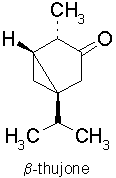Thujone: Difference between revisions
Uncle Jesse (talk | contribs) mNo edit summary |
Uncle Jesse (talk | contribs) No edit summary |
||
| Line 5: | Line 5: | ||
It is best known as a component of the drink [[absinthe]], as it is a natural oil of [[wormwood]] (''[[Artemisia absinthium]]''). Although the compound is credited with hallucinogenic properties this is not certain; it is structurally close to Tetrahydrocannabinol (THC) and is certainly toxic but each isomer has distinct differences. | It is best known as a component of the drink [[absinthe]], as it is a natural oil of [[wormwood]] (''[[Artemisia absinthium]]''). Although the compound is credited with hallucinogenic properties this is not certain; it is structurally close to Tetrahydrocannabinol (THC) and is certainly toxic but each isomer has distinct differences. | ||
Latest revision as of 23:44, 15 December 2022
Thujone (C10H16O) is a chemical compound. It is a colourless liquid with a distinctive menthol odour, it is a ketone, a monoterpene, and is found in two stereoisomeric forms - (+)-3-thujone or α-thujone and (-)-3-thujone or β-thujone. It boils at 201°C, is insoluble in water although it is readily soluble in ethanol or diethyl ether.
It is found in certain plants such as arborvitae (genus Thuja, whence the derivation of the name), Nootka Cypress, some junipers, mugwort, sage, and wormwood, usually as a mix of isomers in a 1:2 ratio. Its name is sometimes given structurally as bicyclo (3.1.0) hexan-3-one, 4-methyl-1-(1-methylethyl)-,(1S-(1-, 4-, 5-α))-(9CI), other names used include isothujone and thujanone. It is used as a flavouring agent in certain foods and is a compound in a number of other food additives.
It is best known as a component of the drink absinthe, as it is a natural oil of wormwood (Artemisia absinthium). Although the compound is credited with hallucinogenic properties this is not certain; it is structurally close to Tetrahydrocannabinol (THC) and is certainly toxic but each isomer has distinct differences.
